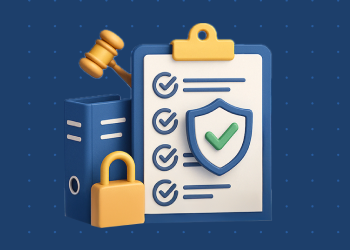Most managed service providers (MSPs) probably wish they didn’t have to worry about compliance management. Compliance requirements can complicate MSP operations and increase their costs.
But, like it or not, compliance is a fact of life for most MSPs. Compliance management failures may lead to legal and financial problems. It can also increase customer churn because the businesses that hire MSPs typically expect their service providers to be adept at handling compliance responsibilities.
This means that an effective MSP compliance management strategy is one that recognizes the full depth and breadth of compliance commitments that MSPs need to meet, while at the same time aiming to streamline compliance operations. The more efficiently and cost-effectively MSPs can address compliance challenges, the better positioned they are to remain competitive and profitable.
With that reality in mind, here’s a look at what today’s MSPs need to know about compliance management. This article explains what compliance management means, why MSPs sometimes struggle to meet compliance requirements and how they can develop and implement compliance management strategies that are effective at addressing compliance responsibilities, while at the same time keeping operations streamlined and cost-effective.
What is Compliance Management?
Compliance management is the strategy and processes that a business uses to meet its compliance obligations.
Those obligations include mandates defined by regulatory compliance frameworks – such as the Health Insurance Portability and Accountability Act (HIPAA), which regulates the management of healthcare data in the United States, or the General Data Protection Regulation (GDPR), a European Union law designed to protect personal information. MSPs that operate in industries and jurisdictions regulated by these laws have a legal obligation to comply with them.
Compliance requirements may also include rules or practices established by voluntary frameworks, like ISO 27001 or the NIST Cybersecurity Framework (CSF). These are both examples of frameworks that organizations can adopt to improve their cybersecurity hygiene, but they are not legally mandatory in most cases. (NIST CSF is a requirement for U.S. federal agencies and their contractors, but other organizations may opt to follow the NIST cybersecurity standards voluntarily.)
For an MSP business, the key steps in compliance management include:
- Identifying requirements: The MSP must determine which compliance rules it aims to meet, either because it has a legal obligation to do so or because it voluntarily chooses to adhere with a given compliance framework.
- Implement compliance practices: The MSP must establish practices that allow it to meet the relevant compliance requirements.
- Demonstrate compliance: The MSP collects evidence to prove that it is meeting those requirements. Customers or auditors may ask for this information to confirm that the MSP is compliant.
Common Compliance Challenges for MSPs
In theory, implementing a compliance management strategy may seem straightforward enough. In practice, however, MSPs sometimes struggle to manage compliance effectively for a variety of reasons.
Diverse Client Compliance Needs
Perhaps the only greatest compliance challenge facing the typical MSP is the need to comply with multiple frameworks simultaneously.
This is the case because MSPs are typically subject to any compliance regulations that are in effect in the country or region where they are based. In addition, MSPs must comply with regulations that impact their clients, even if those clients are in different jurisdictions and therefore subject to different compliance requirements from MSPs themselves. On top of this, MSPs must be prepared to adhere to any voluntary compliance frameworks that they or their customers choose to adopt.
For these reasons, it’s critical for MSPs to evaluate carefully which compliance frameworks are relevant to them. It’s also crucial to reassess compliance needs whenever they onboard a new client, since the new customer could be subject to compliance mandates that don’t affect existing clients.
Conflating Compliance with Security
Sometimes, MSPs assume that so long as they address cybersecurity requirements, they are also meeting compliance requirements. In reality, many compliance mandates include more than just cybersecurity rules.
For example, GDPR requires that organizations allow users to request deletion of their personal data in addition to keeping such data secure. Simply protecting the information from attack wouldn’t be sufficient for meeting GDPR mandates.
This factor makes it important for MSPs to differentiate between compliance and cybersecurity. Cybersecurity is part of compliance, but compliance management requires much more than just cybersecurity hygiene.
Constantly Evolving Compliance Mandates
Compliance frameworks are constantly changing as new regulations (like DORA, to cite just one example of a framework that has recently taken effect) come online and existing frameworks (such as PCI DSS, which was overhauled in 2024) are modified.
As an MSP, it can be challenging to keep track of constantly changing rules. Subscribing to regulators’ communication channels and following MSP-centric communities and groups can help, but there is no way to guarantee that you’ll receive notification of every compliance update that is relevant to your business.
Evidence Management
As noted above, compliance management for MSPs requires not just implementing processes to comply with relevant frameworks, but also documenting that compliance is taking place. The process of collecting and tracking such evidence can be onerous, especially for MSPs that don’t build evidence management practices into their operations.
For example, if you don’t factor compliance requirements into log retention policies, you might delete older log files that are an important source of compliance documentation.
Limited Resources
A final compliance management challenge for MSPs is that they typically have limited resources, and their main focus is on maximizing the ROI that those resources generate. Because compliance doesn’t directly generate revenue, MSPs may see compliance practices as a poor use of resources, then under-invest in.
Why MSPs Should Care About Compliance Management
While it may seem natural for MSPs to want to minimize compliance investments, a healthier perspective is to view compliance management as an opportunity that can help MSPs thrive. This is true for two main reasons.
First, effective compliance practices help MSPs acquire and retain customers. Clients are likely to cancel contracts, or to decline working with your MSP business in the first place, if you cannot demonstrate that your organization is prepared to comply with the regulations and frameworks that impact customers. In this sense, poor compliance management translates to a loss of business.
In addition, failing to meet compliance obligations may have legal consequences. Regulators could fine MSPs directly for compliance oversights. Clients could also sue if an MSP fails to meet compliance obligations to which it has made a contractual commitment.
Building a Compliance Management Strategy That Works
As for how to implement effective compliance management for an MSP business, consider the following best practices:
- Build compliance into managed services: In most cases, the best way to manage compliance as an MSP is to integrate compliance obligations into the core services you deliver. Rather than treating compliance as an afterthought or a siloed process, ensure that compliance procedures and evidence collection occur automatically as part of your standard operations.
- Employee certifications: Certifications are available for most major frameworks to demonstrate employees’ readiness to meet compliance requirements.
- Customer training: Training customers to follow compliance best practices is another way to help minimize risk. As an MSP, you may not be able to control fully what your customers do, but you can use education to encourage practices that align with compliance mandates within systems you manage on customers’ behalf.
- Customer auditing: You can perform audits of your customers’ environments, or hire an auditing firm to do this for you, as a way of validating whether compliance oversights exist.
- Documentation auditing: Auditing your own documentation is another means of detecting potential compliance oversights or lack of sufficient evidence to demonstrate compliance.
- Automated compliance: Increasingly, automation technology is available to help MSPs to detect compliance oversights, as well as collect evidence. For example, automated scanning of access control policies could detect potential compliance violations. Automation software could also pull evidence from source systems, eliminating the need for employees to collect the data manually.
Conclusion: Compliance Management as a Key to MSP Success
The bottom line: Compliance management may be tedious, but it plays an essential role in MSP revenue generation and profitability. You can’t run a successful MSP business without an effective compliance management strategy – which is why it’s critical to take the time to assess your compliance obligations, implement processes to meet them and ensure that you have the documentation and other evidence necessary to prove compliance.




